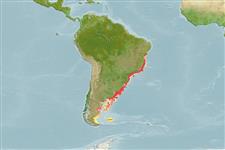Common names from other countries
>
Pleuronectiformes (Flatfishes) >
Paralichthyidae (Large-tooth flounders)
Etymology: Paralichthys: Greek, para = the side of + Greek, ichthys = fish + Greek, suffix, oides = similar to (Ref. 45335).
Environment: milieu / climate zone / depth range / distribution range
ນິເວດວິທະຍາ
ສັດທະເລ; ນ້ຳກ່ອຍ ອາໄສຢູ່ໃກ້ໜ້າດິນໃຕ້ພື້ນທ້ອງນ້ຳ; ລະດັບຄວາມເລິກ 0 - 40 m (Ref. 26375). Subtropical; 12°S - 54°S
Southwest Atlantic: Brazil. Does not occur in Argentina nor in Uruguay (Ref. 43588).
ຂະໜາດ / ນ້ຳໜັກ / Age
Maturity: Lm ? range ? - ? cm
Max length : 100.0 cm TL ຕົວຜູ້/ບໍ່ມີເພດ; (Ref. 26375); common length : 40.0 cm TL ຕົວຜູ້/ບໍ່ມີເພດ; (Ref. 6077); ນ້ຳໜັກສູງສຸດທີ່ເຄຍຈັດພີມມາ: 12.0 kg (Ref. 26375)
ຄີ (ໜາມ)ແຂງຢູ່ຫຼັງປາ (ທັງໝົດ) : 0; ຄີຫຼັງຂອງປາ (ຄີອ່ອນ) (ທັງໝົດ) : 68 - 86; ຄີ(ໜາມ) ແຂງຢູ່ຄີກົ້ນປາ
ກຸ່ມປາກະດູກແຂງ
ຄວາມຖີ່ຂອງກຸ່ມຖ່າຍທອດພັນ
ປາທີ່ມີການເຄື່ອນຍ້າຍຈາກທະເລໄປຫານ້ຳຈືດ ແລະນ້ຳຈືດຫາທະເລ
ປາທີ່ມີການເຄື່ອນຍ້າຍຈາກທະເລແລະໄປໄຂ່ຢູ່ນ້ຳຈືດ
ຄີກົ້ນຂອງປາ
ສັດທີ່ມີກະດູກສັນຫັຼງ
ການຖ່າຍທອດທາງກຳມະພັນຈາກພໍ່ແມ່ຫາລູກ: 0; ຄີກົ້ນຂອງປາ: 52 - 67. Pectoral fins small, about two times head on ocular side, 2.7-3.0 time head on blind side. Pelvic fins about equal in size and shape on both sides. Caudal fin double truncate (Ref. 27363).
Inhabits coastal areas, in bays and estuaries (Ref. 36453). Found over sandy or muddy substrate. Apparently, reproduction occurs during summer in small groups of 3-15 individuals. Adults are solitary. This species is very much appreciated for its taste and high commercial value.
Life cycle and mating behavior
Maturities | ການສືບພັນ | Spawnings | Egg(s) | Fecundities | ຕົວອ່ອນ
Distinct pairing (Ref. 205).
Cervigón, F. and W. Fischer, 1979. INFOPESCA. Catálogo de especies marinas de interes economico actual o potencial para América Latina. Parte 1. Atlántico centro y suroccidental. FAO/UNDP, SIC/79/1. 372 p. FAO, Rome. (Ref. 6077)
IUCN Red List Status (Ref. 130435)
CITES (Ref. 128078)
Not Evaluated
Threat to humans
Harmless
Human uses
ການປະມົງ: ເປັນສີນຄ້າ; ຊະນິດປາທີ່ຖືກນຳໃຊ້ເຂົ້າໃນການຫາເພື່ອເປັນເກມກິລາ: ແມ່ນ
ເຄື່ອງມື
Special reports
Download XML
ແຫຼ່ງອີນເຕີເນັດ
Estimates based on models
Preferred temperature (Ref.
115969): 11.7 - 26.1, mean 16.1 (based on 150 cells).
Phylogenetic diversity index (Ref.
82804): PD
50 = 0.5000 [Uniqueness, from 0.5 = low to 2.0 = high].
Bayesian length-weight: a=0.00646 (0.00384 - 0.01085), b=3.16 (3.02 - 3.30), in cm Total Length, based on LWR estimates for this species & Genus-body shape (Ref.
93245).
ຊັ້ນເຂດຮ້ອນ (Ref.
69278): 4.4 ±0.6 se; based on size and trophs of closest relatives
ຄວາມຢືດຢຸ່ນ (Ref.
120179): ຂະໜາດກາງ, ປະຊາກອນຕຳ່ສຸດທີ່ໃຊ້ເວລາສອງເທົ່າ 1.4 - 4.4 ປີ (Preliminary K or Fecundity.).
Fishing Vulnerability (Ref.
59153): High vulnerability (60 of 100).
